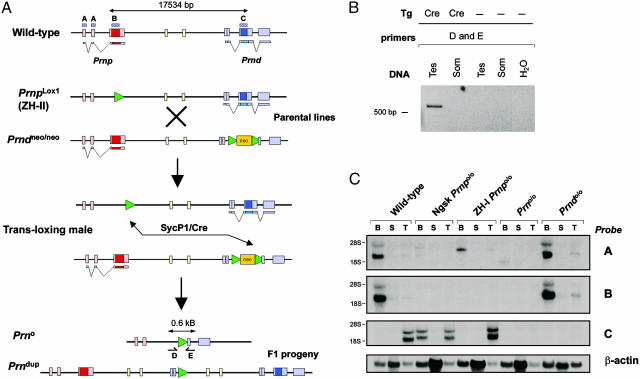Fig. 1.
Recombination strategy. (A) Schematic representation of Cre-mediated TAMERE. In ZH-II mice, 0.26 kb of intron 2, the entire PrP ORF, and the 3′ noncoding region of exon 3 were replaced by a 34-bp loxP sequence. In Prndneo/neo mice, the Dpl ORF was replaced by a selection cassette flanked by loxP sequences. These lines were intercrossed to produce triple transgenic “transloxing” males containing the Prnplox1, Prndneo, and SycP1-Cre alleles (Fig. 1 A). After chromosome pairing and Cre expression in meiotic prophase, transallelic recombination generates two novel alleles. In the first allele (Prn°), the intergenic sequence is deleted. In the second allele (Prndup), the intergenic sequence between Prnp and Prnd is produced in the same orientation as in the original Prndup. Boxes in A–C show DNA probes used for Northern blot analysis. (B) PCR amplification of genomic DNA from testes of transloxing males, with or without the SycP1-Cre transgene. Primers D and E amplify a 0.6-kb fragment diagnostic of the deleted locus only in presence of Cre. No recombination was found in somatic transloxer tissues. (C) Northern blot analysis confirmed the absence of any transcripts in the Prno/o mice with probe B and C in different tissues, but a weak band was detected with probe A. Dup, duplication; Tes, testis; Som, somatic; B, brain; S, spleen; T, testis.

